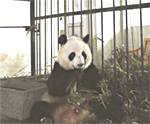China Hoping Advanced Technology will Save Giant Panda from ExtinctionThe twins were born July 13 after their mother was impregnated by artificial insemination at this research center in southwestern China. Thirteen other giant pandas are pregnant and expected to give birth within a few months -- part of a campaign to rescue China's national symbol from the brink of extinction. China is pouring tens of millions of dollars into the campaign in hopes of speeding up the birth rate of giant pandas in captivity so they can one day release them into the wild. Research is also under way to clone pandas, using bears and rabbits as surrogate mothers. But scientists concede their chances of success are slim without more efforts to fight the main cause of the giant panda's decline -- the rapid destruction of its bamboo forest habitat. With its distinctive plump white face and black eye patches and ears, the panda has become the world's poster child for endangered species. Giant pandas once roamed much of China and northern Vietnam looking for the bamboo that makes up most of their diet. But human activity has steadily pushed them into a shrinking area of steep, forested mountains in China's southwest near Tibet. Even that remote sanctuary has fallen to the ax and saw since economic development took off in the 1980s. Scientists estimate the number of giant pandas in the wild has dropped by half in the last two decades. A survey in April counted fewer than 1,000. One reason pandas have failed to adapt is their slow birth rate. In zoos, most refuse to mate. Even in the wild, scientists estimate that females give birth only once every 2 1/3 years. A laboratory in Beijing is studying cloning as a way to speed up breeding. The 2-year-old project run by the official Chinese Academy of Sciences refused visits by reporters. But administrator Shen Chuangli said scientists there have succeeded in extracting DNA from a bear's egg and replacing it with that of a panda. The genetically altered ovum was then placed in a bear's womb but failed to grow. Shen said China is years away from producing a healthy panda clone. "The current technology is far from mature," he said. Artificial insemination has offered more success in overcoming the panda's reluctance to procreate. Since the first artificially conceived cub in 1963, 210 have been born in China and 20 overseas. But only about half have survived to adulthood. Pandas born in captivity have less resistance to disease and mothers sometimes abandon their young. At the Chengdu Research Base, outside the city of Chengdu in Sichuan province, newborns like Shen-Shen and Ao-Ao are taken from their mother at birth. Too young to open their eyes, the twins are kept in separate incubators and drink milk formula from baby bottles held by researchers in white coats. The careful attention means the average six pandas born there each year now survive, said Li, the head of the breeding project. The cubs are kept for research or sent to zoos. The Chengdu breeding project has had remarkable success, according to Rebecca Snyder, coordinator of giant panda research at Zoo Atlanta who has done research at the Chinese center since 1997. "It's one of the best captive facilities in the world," said Snyder of the center's success in breeding, artificial insemination and survival rates of cubs after birth. "It's important when a species is endangered in the wild because of loss of habitat to have a captive population that acts as a gene reservoir for reintroduction one day," she said, adding that pandas were good candidates for reintroduction because they do not have to be taught to hunt and have few natural predators. Li said he hopes a proposed US$80 million expansion will allow the center to breed enough pandas to start releasing them into the wild. But by that time, there may be little forest left. A government survey three years ago showed panda habitat had shrunk by 90 percent in some areas since the late 1980s. Beijing says it will spend US$36 million to double protected areas in Sichuan and neighboring Shaanxi and Gansu provinces to 2.5 million acres. Experts say that's not enough. China's 34 existing panda reserves need more rangers to stop illegal loggers and poachers. And nothing has been done to relocate thousands of people still living in those reserves, who continue to clear trees and open up new farmland. "Until the problem of habitat is solved, there is no way to really talk about saving the panda,'' said Wang Dajun, a panda researcher at Peking University. |
| People's Daily Online --- http://english.peopledaily.com.cn/ |


